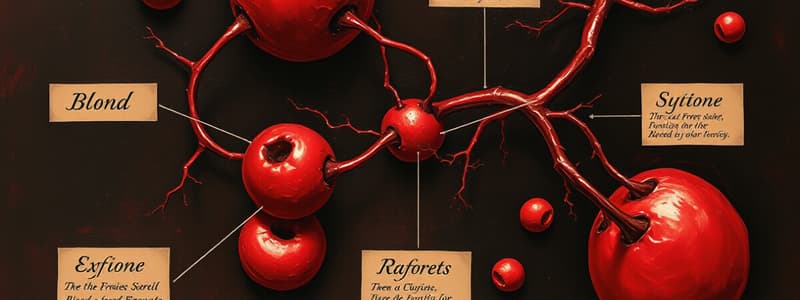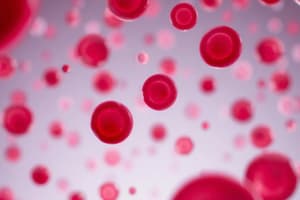Podcast
Questions and Answers
Which of the following is not a formed element in the blood? (Select one)
Which of the following is not a formed element in the blood? (Select one)
- Red blood cells
- White blood cells
- Platelets
- Organic molecules and salts (correct)
Which of the following is not a function of blood? (Select one)
Which of the following is not a function of blood? (Select one)
- Defense of the body
- Regulation of body temperature
- Transport of oxygen and carbon dioxide
- Manufacture of hormones (correct)
The pigment that transports oxygen in an erythrocyte is: (Select one)
The pigment that transports oxygen in an erythrocyte is: (Select one)
- Deoxyhemoglobin
- Fibrin
- Hemoglobin (correct)
- Plasma
When the oxygen capacity of the blood is reduced, which occurs? (Select one)
When the oxygen capacity of the blood is reduced, which occurs? (Select one)
The majority of the carbon dioxide produced by cellular respiration is transported by the red blood cell (RBC) by: (Select one)
The majority of the carbon dioxide produced by cellular respiration is transported by the red blood cell (RBC) by: (Select one)
Which of the following contains blue-stained granules and releases histamine? (Select one)
Which of the following contains blue-stained granules and releases histamine? (Select one)
Which cells include B cells and T cells that provide specific immunity? (Select one)
Which cells include B cells and T cells that provide specific immunity? (Select one)
Which blood cells are largest, have no granules, and become macrophages? (Select one)
Which blood cells are largest, have no granules, and become macrophages? (Select one)
Which blood cells are the most abundant, have a multilobed nucleus, and are first responders to invasion? (Select one)
Which blood cells are the most abundant, have a multilobed nucleus, and are first responders to invasion? (Select one)
Which of the following are formed from megakaryocytes? (Select one)
Which of the following are formed from megakaryocytes? (Select one)
Which of the following is the correct sequence for blood clotting? (Select one)
Which of the following is the correct sequence for blood clotting? (Select one)
Theoretically, a person with type AB blood should be able to receive which types of blood? (Select one)
Theoretically, a person with type AB blood should be able to receive which types of blood? (Select one)
Blood is associated with which forms of homeostasis? (Select one)
Blood is associated with which forms of homeostasis? (Select one)
The blood cells exchange oxygen, carbon dioxide, and nutrients with the __________ surrounding the cells of the body.
The blood cells exchange oxygen, carbon dioxide, and nutrients with the __________ surrounding the cells of the body.
Type B blood contains __________ surface antigens on the RBC's __________ and antibodies in the plasma.
Type B blood contains __________ surface antigens on the RBC's __________ and antibodies in the plasma.
Which of the following is not true of white blood cells? (Select one)
Which of the following is not true of white blood cells? (Select one)
Flashcards
What is blood?
What is blood?
The liquid part of blood, composed of plasma and formed elements. Formed elements include red blood cells, white blood cells, and platelets.
What do red blood cells do?
What do red blood cells do?
Red blood cells are responsible for transporting oxygen throughout the body. They contain hemoglobin, a protein that binds to oxygen.
What are white blood cells?
What are white blood cells?
White blood cells are part of the immune system, protecting the body against infections. They can be classified into different types, such as neutrophils, lymphocytes, and monocytes.
What are platelets?
What are platelets?
Signup and view all the flashcards
What are some functions of blood?
What are some functions of blood?
Signup and view all the flashcards
What is hemoglobin?
What is hemoglobin?
Signup and view all the flashcards
What is erythropoietin?
What is erythropoietin?
Signup and view all the flashcards
How is carbon dioxide transported in the blood?
How is carbon dioxide transported in the blood?
Signup and view all the flashcards
What are basophils?
What are basophils?
Signup and view all the flashcards
What are lymphocytes?
What are lymphocytes?
Signup and view all the flashcards
What are monocytes?
What are monocytes?
Signup and view all the flashcards
What are neutrophils?
What are neutrophils?
Signup and view all the flashcards
What are megakaryocytes?
What are megakaryocytes?
Signup and view all the flashcards
Describe the blood clotting process.
Describe the blood clotting process.
Signup and view all the flashcards
What is type AB blood?
What is type AB blood?
Signup and view all the flashcards
How does blood contribute to homeostasis?
How does blood contribute to homeostasis?
Signup and view all the flashcards
Study Notes
Formed Elements in Blood
- Formed elements include red blood cells, white blood cells, and platelets.
- Organic molecules and salts are not classified as formed elements.
Functions of Blood
- Blood regulates body temperature and defends the body against pathogens.
- It transports oxygen and carbon dioxide but does not manufacture hormones.
Hemoglobin and Oxygen Transport
- Hemoglobin is the pigment responsible for transporting oxygen in erythrocytes.
- Deoxyhemoglobin is the form of hemoglobin without oxygen.
Erythropoietin Production
- Reduced oxygen capacity in blood triggers kidneys to release erythropoietin, stimulating erythrocyte production.
Carbon Dioxide Transportation
- Majority of carbon dioxide produced by cellular respiration is transported by forming carbonic acid in the plasma of red blood cells.
White Blood Cell Types
- Basophils contain blue-stained granules and release histamine to mediate inflammation.
- Lymphocytes include B cells and T cells, providing specific immunity.
- Monocytes are the largest white blood cells without granules and differentiate into macrophages.
- Neutrophils are the most abundant white blood cells, characterized by a multilobed nucleus, and act as first responders to infection.
Platelet Formation
- Platelets are formed from megakaryocytes in the bone marrow.
Blood Clotting Process
- The blood clotting sequence involves prothrombin activator, prothrombin to thrombin, and thrombin converting fibrinogen to fibrin threads.
Blood Type Compatibility
- Individuals with type AB blood can receive blood from type A, B, or O donors.
Homeostasis Functions of Blood
- Blood plays a crucial role in homeostasis, supplying nutrients, gases (oxygen and carbon dioxide), removing waste, and transporting hormones.
Exchange with Interstitial Fluid
- Blood cells exchange oxygen, carbon dioxide, and nutrients with interstitial fluid surrounding body cells.
Antigen and Antibody Composition
- Type B blood has B surface antigens on red blood cells and anti-A antibodies in the plasma.
Facts About White Blood Cells
- White blood cells are produced in red bone marrow but do not transport oxygen and carbon dioxide; they can migrate out of the bloodstream to fight infections.
Studying That Suits You
Use AI to generate personalized quizzes and flashcards to suit your learning preferences.




